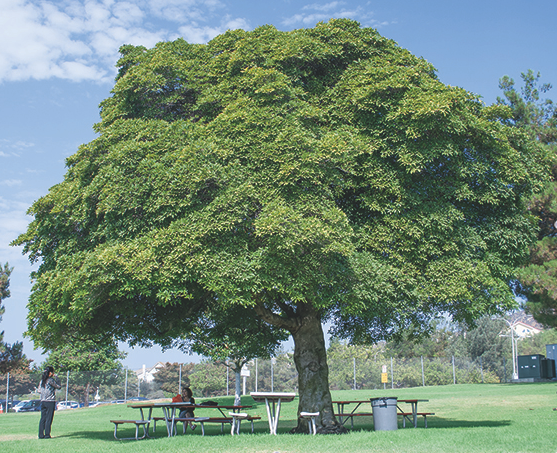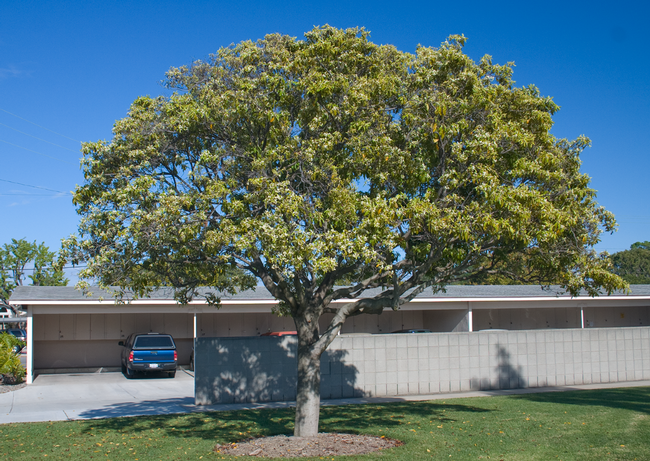
Victorian box (Pittosporum undulatum) is an evergreen tree native to Australia that grows moderately fast to about 50 feet high and wide. It was much planted as an ornamental landscape subject in the first half of the 20th century in coastal central and southern California, especially from Santa Barbara to San Diego, where it was used as a lawn or street tree, background, screen, or informal hedge, and prized for its dense canopy, attractive and glossy green foliage, fragrant white flowers, showy orange fruits, and ease of cultivation (Figure 1). Indeed, from late January through March, especially in the evening, one can detect the wonderful, sweet, somewhat citrus-like fragrance of its flowers wafting through the air in older neighborhoods. Victorian box has somewhat fallen out of favor as a landscape subject in the last 40 years but is still found in nurseries and as old and young plants in the landscape. Typically a vigorous grower, trunks can attain one to two feet in diameter; and the tree can produce copious amounts of fruits, which readily germinate and produce seedlings in irrigated landscapes.
Over the last 25 years, arborists, horticulturists, landscape managers, and others have frequently noticed a widespread decline of older, established Victorian box trees in Southern California. Affected trees tend to lose vigor gradually but steadily; canopies thin; leaves yellow, die, and drop; and twigs and branches die back, either generally over the whole tree or, at least initially, restricted to one or more branches (Figure 2).
The exact cause of the decline is unknown but is commonly associated with a combination of improper cultivation, old age, and possibly one or more opportunistic pathogens. Improper cultivation, such as too much or too little water, soil compaction, excessive and/or inappropriate pruning, root disturbance or damage, wounds, and competition from adjacent encroaching plants, could stress trees and predispose them to opportunistic pathogens. Because most of the trees exhibiting this decline are old and mature, perhaps overly so, natural senescence is likely a significant contributing factor; rarely are young, small trees, which are usually vigorously growing, showing symptoms. Symptoms generally indicate root damage or death, but isolating soil-borne root pathogens associated with the decline has been difficult and mostly inconclusive. While Phytophthora, Armillaria, Fusicoccum, and Botryodiplodia have been isolated from some declining Victorian box trees, these pathogens are not thought to be the sole or even primary causal agents responsible for the decline. Thus, a combination of factors, including old age, improper cultivation, and several disease pathogens, is likely responsible for the decline.
Provide Proper Cultural Care
The best management strategy for Victorian box decline is prevention through proper culture. When planting a Victorian box, select the right location in the garden or landscape; and plant and care for it properly. Irrigate appropriately, applying sufficient water at each irrigation event to moisten the upper 12 inches of soil. Irrigate again only when the soil one to two inches deep becomes dry, then irrigate once again to moisten the upper 12 inches of soil. This irrigation strategy allows for a slight dry down between irrigation events and encourages a deeper and healthier root system. Avoid disturbing or wounding the roots or compacting the soil; maintain a one- to two-inch layer of mulch (fallen leaves, grass clippings, etc.) over the root zone and six inches from the trunk. Prune only to remove dead branches or to maintain good structure, and when doing so adhere to sound and appropriate pruning practices. Keep encroaching turf grass, groundcovers, shrubs, and weeds at least three feet away from the trunk. Prune back adjacent trees encroaching or overtopping the Victorian box's canopy. Remember that old trees seem more susceptible to the decline, so where practical consider replacing senescing trees with an appropriate species and individual tree.
What about Chemical Control?
There is no proven chemical treatment for declining trees. However, applications of gypsum (calcium sulfate) at the rate of 10 pounds per 100 square feet might help to suppress some root pathogens that may be present.
For information about pests and abiotic disorders on Victorian Box, visit the UC IPM web site.
